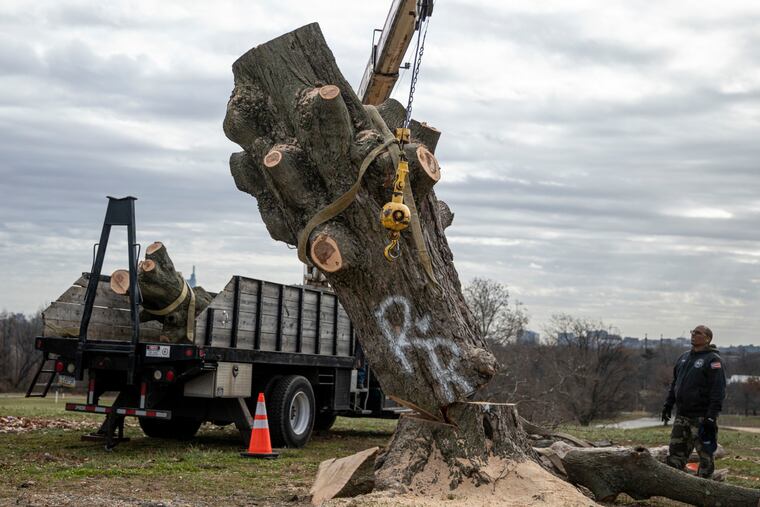The iconic Fairmount Park tree featured in countless Philly skyline photos has been cut down
The tree had been in decline over the past year and officials decided it had to come down for public safety reasons.

A Philadelphia Parks and Recreation employee squeezed a chainsaw trigger at 9:20 a.m. Wednesday and chewed through the first of many limbs, ending the decades-long reign of an iconic 70-foot-high sugar maple over the city skyline.
The rest of the 40-inch-diameter tree, which stood solo atop a grassy slope on West Fairmount Park’s Belmont Plateau, fell by about noon. The tree, a much-photographed backdrop for weddings, dates, picnics, and sledding excursions, had been dying for more than a year, dropping limbs and turning into a public safety hazard.
“The Belmont sugar maple has been part of the background of our lives as Philadelphians,” Kathryn Ott Lovell, Parks and Rec commissioner, said at the site just before crews began their work. “The outpouring of love for this tree speaks to the power that access to green spaces has to our health, our sense of well-being, and our happiness.”
Lori Hayes, urban forestry director for Parks and Rec, estimated the tree’s age at 80 to 100 years. She plans to count its rings to determine its exact lifespan, though the condition of the tree makes counting its rings more difficult. She said it might not be possible to know the real age.
She attributed its decline to climate change, soil being compacted by the feet of so many visitors, and being buffeted by generations of storms.
Hayes said some large, heavy limbs had already broken off in recent weeks and months.
“It’s not safe,” she said. “We would hate for someone to be out here recreating and to be injured by a part of the tree falling. It posed a safety hazard to our users.”
» READ MORE: An iconic Fairmount Park tree featured in countless Philly skyline photos is dying — and being cut down
Maita Soukup, a spokesperson for the department, said she has gotten dozens of requests by residents to acquire pieces of the tree as mementos of special events they associate with it. The department, she said, plans to mill usable pieces into Christmas ornaments, coasters, or slim pieces known as cookies or discs used to make plates and crafts, and possibly sell them to raise funds for the city’s tree program.
Hayes said three black gums will be planted around the site, though not directly on it. Black gums (Nyssa sylvatica) are less susceptible to the milder winters that have harmed local sugar maples. She said black gums, also known as tupelo, are particularly beautiful in fall as the leaves turn scarlet. Hayes said the three trees would help to protect one another. Native to the eastern United States, black gums usually grow 60 to 80 feet high, live many years, and have proved pest and disease resistant.
Pennsylvania’s forest action plan states that sugar maples are a vulnerable tree species threatened by losses associated with climate change. However, sugar maples are also stressed by disease and pests.
As crews cut the tree down, Belmont Mansion Drive was closed to vehicles, so local sculptor Roger Wing was on foot to see if he could get a piece of the tree. Wing, who recounted warm memories associated with the tree over the years, said he had no idea what he would sculpt with it, and would have to wait until he got back to his studio.
Photographer Brad Maule was also at the scene, taking pictures for a local news organization. Maule created the former Philly Skyline website. He moved to Philadelphia in 2000 and said he has photographed the tree hundreds of times since.
“Like so many other people, I can say this tree has been a central part of my experience,” Maule said. “I’ve shot all four seasons, day and night, through rain, sunshine, and snow. It’s been sort of a stand-alone beacon. It’s got the best view of any tree in the park.”